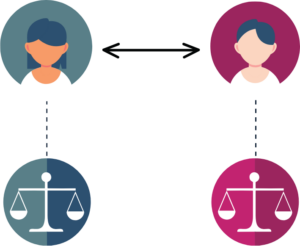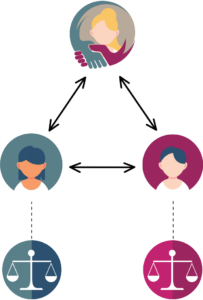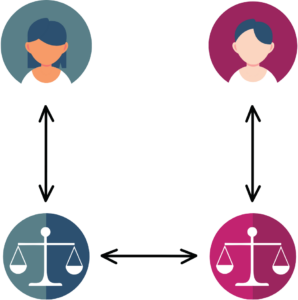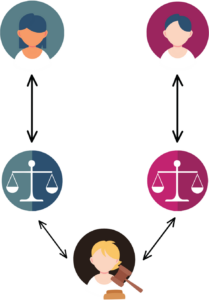Family law disputes can be emotionally taxing and complex, often involving delicate matters such as child custody, asset division, and spousal support. I once worked with clients, Jess and Sam, who discovered the truth in all of this. In such situations, effective dispute resolution mechanisms play a crucial role in resolving conflicts and reaching agreements that are fair and mutually beneficial for all parties involved. This informs relationships going forward and how family systems may continue to function too
It’s important for all clients, including mine, to explore various mechanisms available in family law matters, ranging from direct approaches to litigation/court-based methods, highlighting the evolution of the client’s role in decision-making throughout the process. Jess and Sam struggled with which process to choose and many people do. It is not just what process you think may be best, however, but rather whether you and your spouse are a good fit for the particular method too.
It is clear, whatever the ultimate decision, the client’s role in resolution declines as you approach and/or enter litigation/court-based mechanisms for dispute resolution. This is important information for anyone who is experiencing the emotional upheaval of divorce as understanding various approaches may determine your experience of the process.
In general, it is also true that the more you are able to retain decision-making authority for yourself and your children, the better you and your family will be in the long-run if this can be an option. In the case of Jess and Sam, who struggled with some power dynamics and conflict, it wasn’t a simple answer. In their case, getting good professional advice, as needed, may be crucial to your decision making process too.
Generally speaking, maintaining control over your own choices and those affecting your children often leads to better outcomes for you and your family over time, if such autonomy is possible. However, in situations like that of Jess and Sam, who faced challenges with power dynamics and conflicts, the solution isn’t straightforward. Seeking professional guidance when necessary could be a vital part of the decision-making process as well.
In sum, it is important to decide, for individual families, what may work best and not paint with too broad of a brush what is the “best” approach for everyone. When you know better, you do better and a good coach can help inform your decision making each step of the way.
 Direct Approach: Direct approaches involve the parties communicating with each other directly, either face-to-face or through their legal representatives. This approach allows for open dialogue and the exchange of information without the need for third-party intervention. Clients have full control over the decision-making process, and agreements are reached through mutual understanding and compromise. However, direct approaches may not always be feasible, especially in high-conflict situations where emotions run high and communication breakdowns are common.
Direct Approach: Direct approaches involve the parties communicating with each other directly, either face-to-face or through their legal representatives. This approach allows for open dialogue and the exchange of information without the need for third-party intervention. Clients have full control over the decision-making process, and agreements are reached through mutual understanding and compromise. However, direct approaches may not always be feasible, especially in high-conflict situations where emotions run high and communication breakdowns are common.
 Mediation: In mediation, a neutral third party, known as the mediator, facilitates communication between the parties to help them identify issues, explore solutions, and reach agreements. Unlike litigation, where a judge imposes a decision, mediation empowers clients to actively participate in the resolution of their disputes. The role of the client in decision-making becomes less direct in mediation, as they rely on the mediator to guide the conversation and assist them in finding common ground. However, clients still maintain control over the final outcome and have the opportunity to voice their concerns and preferences throughout the process.
Mediation: In mediation, a neutral third party, known as the mediator, facilitates communication between the parties to help them identify issues, explore solutions, and reach agreements. Unlike litigation, where a judge imposes a decision, mediation empowers clients to actively participate in the resolution of their disputes. The role of the client in decision-making becomes less direct in mediation, as they rely on the mediator to guide the conversation and assist them in finding common ground. However, clients still maintain control over the final outcome and have the opportunity to voice their concerns and preferences throughout the process.
 Collaborative Law Advocacy: Collaborative law advocacy involves a cooperative approach to dispute resolution, where each party retains their own legal counsel and agrees to work together to find solutions outside of court. The collaborative process emphasizes communication, cooperation, and problem-solving, aiming to preserve relationships and minimize the emotional and financial costs associated with litigation. There is also a financial neutral and one or more coaches involved to support the parties too. If agreement is not reached, however, clients must choose a new attorney to pursue litigation. Clients do actively participate in negotiations and decision-making, supported by their attorneys who provide legal guidance and advocacy. While the collaborative approach requires a willingness to compromise and engage in open dialogue, it offers clients greater autonomy and flexibility in crafting agreements that meet their unique needs and priorities.
Collaborative Law Advocacy: Collaborative law advocacy involves a cooperative approach to dispute resolution, where each party retains their own legal counsel and agrees to work together to find solutions outside of court. The collaborative process emphasizes communication, cooperation, and problem-solving, aiming to preserve relationships and minimize the emotional and financial costs associated with litigation. There is also a financial neutral and one or more coaches involved to support the parties too. If agreement is not reached, however, clients must choose a new attorney to pursue litigation. Clients do actively participate in negotiations and decision-making, supported by their attorneys who provide legal guidance and advocacy. While the collaborative approach requires a willingness to compromise and engage in open dialogue, it offers clients greater autonomy and flexibility in crafting agreements that meet their unique needs and priorities.
 Settlement Advocacy: Settlement advocacy involves negotiations between the parties and their legal representatives, with the goal of reaching a settlement agreement without resorting to litigation. Clients rely on their attorneys to advocate on their behalf and negotiate favorable terms, while still maintaining some level of control over the decision-making process. However, as negotiations progress, the client’s role in decision-making becomes less direct, as they may defer to their legal counsel to make strategic decisions and assess the risks and benefits of various settlement options.
Settlement Advocacy: Settlement advocacy involves negotiations between the parties and their legal representatives, with the goal of reaching a settlement agreement without resorting to litigation. Clients rely on their attorneys to advocate on their behalf and negotiate favorable terms, while still maintaining some level of control over the decision-making process. However, as negotiations progress, the client’s role in decision-making becomes less direct, as they may defer to their legal counsel to make strategic decisions and assess the risks and benefits of various settlement options.
 Litigation/Court-Based: In litigation or court-based dispute resolution, the parties present their case before a judge, who ultimately decides the outcome of the dispute. The client’s role in decision-making becomes significantly less direct, as they relinquish control over the process to the court and rely on legal professionals to represent their interests. While litigation may be necessary in certain cases where alternative methods of dispute resolution have failed, it is often time-consuming, expensive, and adversarial, with outcomes that may not fully align with the parties’ preferences.
Litigation/Court-Based: In litigation or court-based dispute resolution, the parties present their case before a judge, who ultimately decides the outcome of the dispute. The client’s role in decision-making becomes significantly less direct, as they relinquish control over the process to the court and rely on legal professionals to represent their interests. While litigation may be necessary in certain cases where alternative methods of dispute resolution have failed, it is often time-consuming, expensive, and adversarial, with outcomes that may not fully align with the parties’ preferences.
Effective dispute resolution mechanisms are essential in resolving family law disputes and reaching agreements that promote fairness, cooperation, and mutual respect. By understanding the various mechanisms available, from direct approaches to litigation/court-based methods, clients can make informed decisions about how to approach their disputes and navigate the complexities of the legal system. Whether through mediation, collaborative law advocacy, settlement advocacy, or litigation, the goal remains the same: to achieve a resolution that meets the needs and interests of all parties involved while minimizing conflict and disruption to familial relationships.
 Cherie Morris, J.D., CDC
Cherie Morris, J.D., CDC
